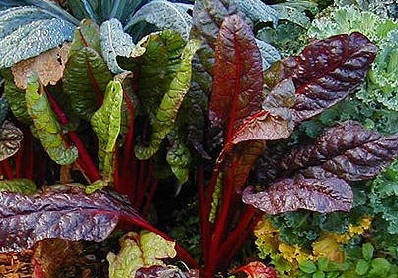|
Swiss Chard -- A Versatile Garden All-Star
Ron Smith
Adams County Master Gardener
Are you looking for a delicious, healthy, easy-to-grow vegetable to plant in your next garden? Consider Swiss chard. It is tasty and nutritious, and about as easy-to-grow as any vegetable you
could plant in the garden.
Swiss chard is a member of the goosefoot family, as are beets and spinach. It is also known as Silver Beet, Spinach Beet, Seakale Beet, Mangold, and Perpetual Spinach. Swiss chard is thought
to have originally been cultivated in Sicily. Chard has crinkly green leaves and its stem color can vary from white to yellow to pink to red. In fact, the plants are so colorful that some gardeners grow chard primarily as an
ornamental. It can also be grown in a container with other ornamentals and moved around the garden, yard, or home during the season.
Chard is packed with nutrients your body needs. According to the one website, www.nutritiondata.com, one cup of cooked chard has over half of your daily requirement of Vitamin C. Chard also
has generous amounts of magnesium, iron, calcium, vitamin K, vitamin A, and vitamin E. One cup of Swiss chard is only 35 calories and is also moderately anti-inflammatory.
 There are many different varieties of chard. The main difference between varieties is stem color. In face, you may notice subtle
differences in taste with different stem colors. As with other vegetables, white stemmed chard has the mildest flavor, while the deep red stemmed chard has the most distinct flavor. "Bright Lights" is a variety that is an
excellent choice for growing chard for the first time. This variety is usually easy to find wherever you buy your vegetable seeds. When planted, "Bright Lights" seedlings will have a wide range of stem color and can be pink,
garnet red, golden yellow, orange, or white. There are many different varieties of chard. The main difference between varieties is stem color. In face, you may notice subtle
differences in taste with different stem colors. As with other vegetables, white stemmed chard has the mildest flavor, while the deep red stemmed chard has the most distinct flavor. "Bright Lights" is a variety that is an
excellent choice for growing chard for the first time. This variety is usually easy to find wherever you buy your vegetable seeds. When planted, "Bright Lights" seedlings will have a wide range of stem color and can be pink,
garnet red, golden yellow, orange, or white.
Swiss chard can be planted in the garden in early spring, which is generally 3 weeks before the last anticipated frost date. In the Adams County area, this is typically sometime during the
second week in April. Seed can be sown when the ground has warmed to 50 degrees F or as soon as the soil can be worked. The seeds should be planted 2 inches apart in rows that are 12 inches apart. After the seedlings have
sprouted, they can be thinned to 10-12 inches apart.
Swiss chard is low maintenance, heat tolerant, and grows in many different garden environments. It will grow in full sun, but will do better with partial shade, particularly afternoon shade.
Like other vegetables, it will do better if weeding is done weekly, especially until first harvest. Swiss chard does not typically need fertilizing as it does not have high nutritional requirements. Watering will be
necessary during dry periods. Water availability affects both leaf quality and quantity. Any leaves which are old or showing stress should be cut and discarded.
Another attractive characteristic of chard is that it can be harvested continually over the entire growing season. The leaves are usually ready for harvest 7 to 8 weeks after planting. Chard
can be harvested anytime after the plant has 5-6 leaves and they are at least 6 inches long. Generally, leaves 6 to 9 inches long are the most mild and tender. In fact, some gardeners refer to young chard as ‘butter chard’
because of its very mild taste and smooth texture. Leaves of this size are also the easiest to work with when preparing in the kitchen. Leaves can grow to 18 inches, and can be harvested at any length over 6 inches, but
older stems will become tough and stringy.
Chard should be harvested using a knife. Cut the leaves 1-2 inches from the ground. Be careful when cutting not to injure the very small and tender leaves developing at the center of the
plant or the plant will not continue to produce new leaves. Always allow a few leaves to remain on the plant so it can continue to make food and keep growing and producing. With careful harvesting, Swiss chard can be taken
out of the garden through early November, well past the first few frosts.
So for a tasty, easy-to-grow leafy vegetable that is packed with nutrition and just keeps on producing over a very long season, Swiss chard is an excellent choice for your garden.
Read other articles on growing herbs or vegetables
|